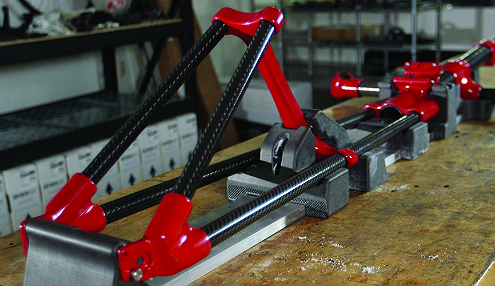Stratasys has introduced a new carbon fiber material for fused deposition modeling (FDM). While the company has had a carbon fiber filament available on their industrial printers for several years, this is the first carbon-based option for their F123 series.
The new filament is called ABS-CF10, and it’s based on ABS thermoplastic. The “CF-10” stands for Carbon Fiber 10, as the filament is 10 percent chopped carbon fiber by weight. The carbon fiber makes it 15% stronger and over 50% stiffer than their standard ABS filament, and Stratasys bills it as a “compelling alternative to metal parts.”
ABS-CF10 is meant for the Stratasys F123 line of “benchtop” printers, lighter than the company’s Fortus industrial systems. According to the company’s press release, it will work specifically with the heavy-duty F170, F270, and F370 printers. The company has not specified yet whether it will work with the newer, smaller F120.
In some ways, this release has been a long time coming. Stratasys founder S. Scott Crump filed the first patent for an FDM printer back in 1989, but copycat FFF-style printers have been printing with carbon fiber filaments for more than five years as a part of a larger development of carbon fiber 3D printing techniques, which also include continuous fiber reinforcement.
Before this release, Stratasys only had carbon fiber-based material available for their industrial printers. Their nylon 12 carbon fiber (FDM Nylon 12CF), released in 2017, was made for their industrial Fortus printers. Nylon 12CF is 35% carbon fiber by weight, and Stratasys said it boasted the best stiffness-to-weight ratio of any of their FDM thermoplastics. Accordingly, it was made for designers and engineers putting together low volume production parts and working prototypes, and has been popular in industrial scale applications like jigs, fixtures, and tooling.

The red-painted parts on this bike frame were printed with Stratasys’ Nylon 12CF, the company’s sole FDM carbon fiber option before this new release (Image courtesy of Stratasys).
Indeed, it was so popular that Stratasys put out an entirely new printer to deal with it. They released the Fortus F380mc, a pared-down version of the Fortus 450 that was only capable of printing in carbon fiber, back in 2018.
With the new release, Stratasys is focused on applications in aerospace, automotive, industrial, and recreational manufacturing industries.
“There is a reason why manufacturers are increasingly turning to 3D-printed carbon fiber materials,” said Dick Anderson, Stratasys Senior VP of Manufacturing. “It’s incredibly strong, versatile, and lightweight. We want to enable all our FDM customers to take advantage of those material characteristics.”
F123 users can look forward to getting their hands on ABS-CF10 this April.
Subscribe to Our Email Newsletter
Stay up-to-date on all the latest news from the 3D printing industry and receive information and offers from third party vendors.
Print Services
Upload your 3D Models and get them printed quickly and efficiently.
You May Also Like
3D Printing News Briefs, June 11, 2025: Sustainability, Automotive Tooling, & More
We’re starting with sustainability news in today’s 3D Printing News Briefs, as EOS has strengthened its commitment on climate responsibility, and Zestep is making 3D printing filament out of eyewear...
3D Printing 50 Polymer Stand-In Parts for Tokamaks at the PPPL & Elytt Energy
Of all the world’s things, a tokamak is one of the hardest, most complex, expensive and exacting ones to make. These fusion energy devices make plasma, and use magnets to...
3D Printing News Briefs, May 17, 2025: Color-Changing Materials, Humanoid Robot, & More
We’re covering research innovations in today’s 3D Printing News Briefs! First, Penn Engineering developed 3D printed materials that change color under stress, and UC Berkeley researchers created an open source,...
Firehawk Aerospace Partners with JuggerBot 3D, Gets $1.25M from AFWERX for 3D Printed Propellants
Texas-based Firehawk Aerospace, an advanced energetic materials firm that works with aerospace and defense applications, announced a strategic partnership with JuggerBot 3D, an Ohio-based large-format 3D printer manufacturer. Together, the...

































